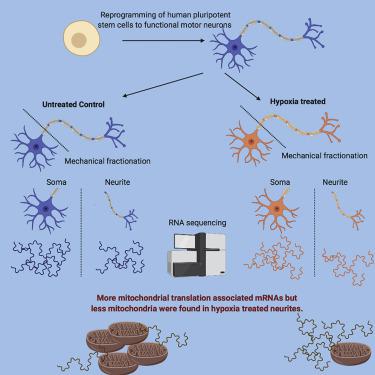Stem Cell Reports ( IF 5.9 ) Pub Date : 2020-05-07 , DOI: 10.1016/j.stemcr.2020.04.003 Laura I Hudish 1 , Andrew Bubak 2 , Taylor M Triolo 1 , Christy S Niemeyer 2 , David S Lorberbaum 1 , Lori Sussel 1 , Maria Nagel 2 , J Matthew Taliaferro 3 , Holger A Russ 1

|
Human motor neuron (MN) diseases encompass a spectrum of disorders. A critical barrier to dissecting disease mechanisms is the lack of appropriate human MN models. Here, we describe a scalable, suspension-based differentiation system to generate functional human MN diseases in 3 weeks. Using this model, we translated recent findings that mRNA mis-localization plays a role in disease development to the human context by establishing a membrane-based system that allows efficient fractionation of MN cell soma and neurites. In response to hypoxia, used to mimic diabetic neuropathies, MNs upregulated mitochondrial transcripts in neurites; however, mitochondria were decreased. These data suggest that hypoxia may disrupt translation of mitochondrial mRNA, potentially leading to neurite damage and development of neuropathies. We report the development of a novel human MN model system to investigate mechanisms of disease affecting soma and/or neurites that facilitates the rapid generation and testing of patient-specific MN diseases.
中文翻译:

使用快速和可扩展的人类运动神经元分化系统对低氧引起的神经病进行建模。
人类运动神经元(MN)疾病涵盖多种疾病。剖析疾病机制的关键障碍是缺乏合适的人类MN模型。在这里,我们描述了一种可扩展的基于悬浮的分化系统,可在3周内产生功能性人类MN疾病。使用该模型,我们通过建立基于膜的系统来有效分离MN细胞的体细胞和神经突,从而将最近的发现转化为mRNA定位在疾病发展中的作用。在用于模拟糖尿病性神经病的缺氧反应中,MNs上调了神经突中的线粒体转录本。然而,线粒体减少了。这些数据表明缺氧可能会破坏线粒体mRNA的翻译,可能导致神经突损伤和神经病变的发展。











































 京公网安备 11010802027423号
京公网安备 11010802027423号